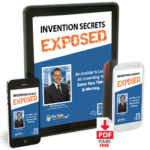What Is a Patent
PATENT INFORMATION
Patent law was first established in the United States Constitution enacted in 1790. A patent for an invention is a property grant conveyed by the United States Patent & Trademark Office (USPTO) to the inventor for a specified period of time. A patent grants the inventor the exclusive right in the United States and its territories and possessions to exclude others from making, using, offering for sale, selling or importing the invention. Although the United States is a first to invent country, an inventor must follow strict guidelines in specific time lines to preserve their rights prior to filing.
There are four different types of filings:
PROVISIONAL PATENT – is a 1-year filing that expires unless continued into aUtility Patent application within a year. The filing needs to include a description of the invention and a drawing. If continued into a utility application, this filing will be made part of the file subject to USPTO scrutiny.
UTILITY PATENT – may be granted for 20 years to inventions and discoveries ofnew, useful and non-obvious articles of manufacture, machine, process or composition of matter, or to any new and useful improvement thereof.
DESIGN PATENT – may be granted for 14 years to inventions that are articles of manufacture having a new and useful ornamental or industrial appearance.
PLANT PATENT – may be granted for 20 years to inventions or discoveries that are an organism asexually reproduced or a new variety of plant
WORLDWIDE PATENT PROTECTION
At present, no “world patents” or “international patents” exist.
In general, an application for a patent must be filed, and a patent shall be granted and enforced, in each country in which you seek patent protection for your invention, in accordance with the law of that country. In some regions, a regional patent office, for example, the European Patent Office (EPO) and the African Regional Intellectual Property Organization (ARIPO), accepts regional patent applications, or grants patents, which have the same effect as applications filed, or patents granted, in the member States of that region.
Further, any resident or national of a Contracting State of the Patent Cooperation Treaty (PCT) may file an international application under the PCT. A single international patent application has the same effect as national applications filed in each designated Contracting State of the PCT. However, under the PCT system, in order to obtain patent protection in the designated States, a patent shall be granted by each designated State to the claimed invention contained in the international application. Further information concerning the PCT is available.
Procedural and substantive requirements for the grant of patents, as well as the amount of fees required, are different from one country/region to the other. It is therefore recommended that you consult a practicing lawyer who is specialized in intellectual property or the intellectual property offices of those countries in which you are interested in getting protection.
WHAT CAN BE PATENTED
The patent law specifies the general field of subject matter that can be patented and the conditions under which a patent may be obtained.
In the language of the statute, any person who “invents or discovers any new and useful process, machine, manufacture or composition of matter, or any new and useful improvement thereof, may obtain a patent,” subject to the conditions and requirements of the law. The word “process” is defined by law as a process, act or method, and primarily includes industrial or technical processes. The term “machine” used in the statute needs no explanation. The term “manufacture” refers to articles that are made, and includes all manufactured articles. The term “composition of matter” relates to chemical compositions and may include mixtures of ingredients as well as new chemical compounds. These classes of subject matter, taken together, include practically everything that is made by man as well as the processes for making the products.
The Atomic Energy Act of 1954 excludes the patenting of inventions useful solely in the utilization of special nuclear material or atomic energy in an atomic weapon. 42 U.S.C. 2181 (a).
The patent law specifies that the subject matter must be “useful.” The term “useful” in this connection refers to the condition that the subject matter has a useful purpose and also includes operativeness, that is, a machine which will not operate to perform the intended purpose would not be called useful, and therefore would not be granted a patent.
Interpretations of the statute by the courts have defined the limits of the field of subject matter that can be patented, thus it has been held that the laws of nature, physical phenomena and abstract ideas are not patentable subject matter.
A patent cannot be obtained upon a mere idea or suggestion. The patent is granted upon the new machine, manufacture, etc., as has been said, and not upon the idea or suggestion of the new machine. A complete description of the actual machine or other subject matter for which a patent is sought is required.
NOVELTY AND NON-OBVIOUSNESS CONDITIONS FOR OBTAINING A PATENT
In order for an invention to be patentable it must be new as defined in the patent law, which provides that an invention cannot be patented if: “(a) the invention was known or used by others in this country, or patented or described in a printed publication in this or a foreign country, before the invention thereof by the applicant for patent,” or “(b) the invention was patented or described in a printed publication in this or a foreign country or in public use or on sale in this country more than one year prior to the application for patent in the United States . . .”
If the invention has been described in a printed publication anywhere in the world, or if it was known or used by others in this country before the date that the applicant made his/her invention, a patent cannot be obtained. If the invention has been described in a printed publication anywhere, or has been in public use or on sale in this country more than one year before the date on which an application for patent is filed in this country, a patent cannot be obtained. In this connection it is immaterial when the invention was made, or whether the printed publication or public use was by the inventor himself/herself or by someone else. If the inventor describes the invention in a printed publication, uses the invention publicly, or places it on sale, he/she must apply for a patent before one year has gone by, otherwise any right to a patent will be lost. The inventor must file on the date of public use or disclosure, however, in order to preserve patent rights in many foreign countries.
Even if the subject matter sought to be patented is not exactly shown by the prior art and involves one or more differences over the most nearly similar thing already known, a patent may still be refused if the differences would be obvious. The subject matter sought to be patented must be sufficiently different from what has been used or described before so that it may be said to be non-obvious to a person having ordinary skill in the area of technology related to the invention. For example, the substitution of one color for another or changes in size are ordinarily not patentable.
For More Information:






